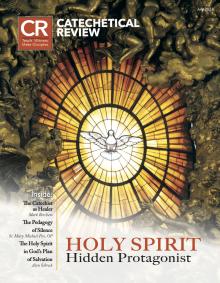St. Thomas Aquinas explained the imagination as “a storehouse of forms received through the senses” that are later called to mind.[1] St. Augustine considered it as a form of “spiritual vision,” distinct from our corporal and intellectual senses.[2] St. Theresa of Ávila described it as one of the most important powers of the soul.[3] Each of these Doctors of the Church spent ample time writing on the power of our imagination and its relationship to the life of faith. They understood that our imagination is part of our physical and spiritual nature. As such, it can affect our bodies and souls for good or for ill. Like all human faculties, our imagination must be trained and developed in order to be healthy, lest it become too weak or disordered—incapable of helping us enter into the reality of this life and the life to come. As catechists, we ought to consider how to form our imagination, and the imagination of those we teach, in the service of our call to holiness.
Jesus, as catechist par excellence, appealed to the imagination of his followers, painting elaborate scenarios. Most of his parables ask the listener to imagine a particular family, place, or circumstance that was common to life. We see him tell stories of disobedient sons (Mt 21:28–32), fiercely stubborn widows (Lk 18:1–8), harvesting wheat (Mt 13:24–30), and herding sheep (Lk 15:1–7). Some parables stretched the limits of the mind’s eye, appealing to circumstances less relatable but still within the grasp of a healthy imagination. Christ spoke of finding treasure (Mt 13:44–46), generous landowners (Mt 20:1–16), and extraordinarily compassionate fathers (Lk 15:11–32). Stories communicate truth and appeal to our imagination in ways that often transcend mere statements. The great southern Catholic author Flannery O’Connor once wrote, “a story is a way to say something that can’t be said any other way . . . You tell a story because a statement would be inadequate.”[4]
Forming a Healthy Imagination
The imagination is above all an integrative power. It reassembles the information that we take in through our senses for the purpose of calling to mind an object or experience in its absence or imagining something new and not yet experienced. I have never seen a purple dog, but I can imagine one. Unlike our external senses that can only perceive the object when it’s acting upon our sense organs, the imagination produces the sense of the object even when these objects are absent. For example, I can imagine a sunset and have its impression affect me without actually seeing it with my eyes.
Forming a healthy imagination requires having as much good and true sensory data as possible. This means that our experience of the natural world is critical, as it serves as the primary foundation of our imagination. As Sr. Thomas More Stepnowski, OP, explains, “the imagination assists in forming an ‘interior landscape’ of the spiritual life which helps us navigate through the dark valleys to the restorative green pastures.” She continues, “For Catholics, the imagination is not an escape to a fantasy world. The imagination aids us in seeing the real world by integrating the natural world and the supernatural world, the visible and invisible.”[5]
The rest of this online article is available for current Guild members.
This article is from The Catechetical Review (Online Edition ISSN 2379-6324) and may be copied for catechetical purposes only. It may not be reprinted in another published work without the permission of The Catechetical Review by contacting [email protected]

















